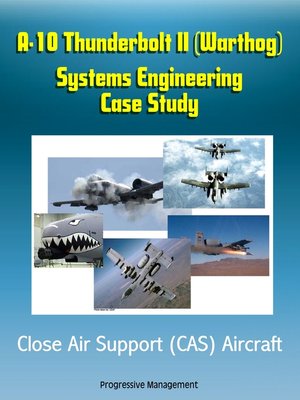A-10 Thunderbolt II (Warthog) Systems Engineering Case Study--Close Air Support (CAS) Aircraft
ebook
By Progressive Management

Sign up to save your library
With an OverDrive account, you can save your favorite libraries for at-a-glance information about availability. Find out more about OverDrive accounts.
Find this title in Libby, the library reading app by OverDrive.



Search for a digital library with this title
Title found at these libraries:
| Loading... |
This is one of a series of systems engineering case studies prepared by the Air Force Center for Systems Engineering. This case study analyzes the A-10A Thunderbolt II, manufactured by Fairchild Republic Corp. between 1975 and 1984. It was specifically designed as a Close Air Support (CAS) aircraft. It was named after another aircraft manufactured by Republic Aircraft, the P-47 Thunderbolt of WW II fame, but is commonly referred to by its nickname, "Warthog", due to its unusual appearance. The A-10, which has survived several attempts of program cancellation and early retirement, is now projected to operate until 2028, well beyond its original requirement. The A-10 has several configurations including the original A-10A, the A-10B, a two-seat version designed for all-weather/night attack and pilot training (only one was produced), the OA-10A, used for forward air controller (FAC) missions, and the recent A-10C, an upgraded version of the A-10A.
The study provides a wealth of technical information about the aircraft and its complex history.
The Department of Defense is exponentially increasing the acquisition of joint complex systems that deliver needed capabilities demanded by our warfighter. Systems engineering is the technical and technical management process that focuses explicitly on delivering and sustaining robust, high-quality, affordable solutions. The Air Force leadership has collectively stated the need to mature a sound systems engineering process throughout the Air Force. Gaining an understanding of the past and distilling learning principles that are then shared with others through our formal education and practitioner support are critical to achieving continuous improvement.
These cases support academic instruction on SE within military service academies, civilian and military graduate schools, industry continuing education programs, and those practicing SE in the field. Each of the case studies is comprised of elements of success as well as examples of SE decisions that, in hindsight, were not optimal. Both types of examples are useful for learning. Along with discovering historical facts, we have conducted key interviews with program managers and chief engineers, both within the government and those working for the various prime and subcontractors. From this information, we have concluded that the discipline needed to implement SE and the political and acquisition environment surrounding programs continue to challenge our ability to provide balanced technical solutions.






